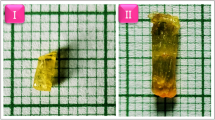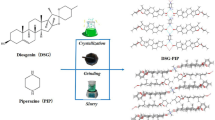Abstract
The two-dimensional potential energy scan shows that the pseudo-trans conformer of 1,5-dinitrobiuret (DNB) is the most stable form of isolated molecule, while the pseudo-cis conformer is about 7.5 kJ/mol higher in energy. Thus, the structure of gaseous DNB is different from that in crystal state, where the molecules have pseudo-cis conformation. The value of enthalpy of formation of gaseous DNB (−257 ± 5 kJ/mol) is calculated from isodesmic reactions using G4 energies. Combining this value with empirically estimated enthalpy of sublimation, the enthalpy of formation of crystal DNB is predicted to be −415 ± 15 kJ/mol. The bond dissociation enthalpies are calculated for all bonds. The energy of the weakest N–NO2 bonds is equal to 190–200 kJ/mol. Similar calculations were carried out for biuret. The gaseous biuret exists predominantly in the pseudo-trans form. The calculated enthalpy of formation of gaseous biuret agrees well with the experimental one. The correlation of calculated bond energies with corresponding bond distances and electron density is discussed for biuret and DNB.




Similar content being viewed by others
References
Teipel U (ed) (2005) Energetic materials. Wiley, Weinheim
Geith J, Holl G, Klapötke TM, Weigand JJ (2004) Combust Flame 139:358
Geith J, Klapötke TM, Weigand JJ, Holl G (2004) Prop Explos Pyrotech 29:3
Liu J, Chambreau SD, Vaghjiani GL (2011) J Phys Chem A 115:8064
Aida K (1961) J Inorg Nucl Chem 23:155
Aida K (1963) J Inorg Nucl Chem 25:165
Freeman HS, Smith JEWL (1966) Acta Crystallogr 20:153
Mintcheva N, Mitew M, Enchev V, Nishihara Y (2003) J Coord Chem 56:299
Thulstrup PW, Larsen E (2006) Dalton Trans 1784
Korolevich MV, Lastochkina VA, Frenkel ML, Kabo GY (1991) J Mol Struct 243:211
Leszczyński J, Sullivan RH (1992) Int J Quant Chem 44:301
Jabalameli A, Nowek A, Hart O, Sullivan R, Leszczynski J (1998) J Mol Struct (Theochem) 425:161
Curtiss LA, Redfern PC, Raghavachari K (2007) J Chem Phys 126:84108
Kozyro AA, Frenkel ML, Krasulin AP, Simirskii VV, Kabo GY (1988) Russ J Phys Chem 62:897
Curtiss LA, Raghavachari K, Redfern PC, Pople JA (1997) J Chem Phys 106:1063
He X, Zhang J, Gao H (2012) Int J Quant Chem 112:1688
Marochkin II, Dorofeeva OV (2012) Comp Theor Chem 991:182
Dorofeeva OV, Kolesnikova IN, Marochkin II, Ryzhova ON (2011) Struct Chem 22:1303
Hehre WJ, Radom L, Schleyer PR, Pople JA (1986) Ab initio molecular orbital theory. Wiley, New York
Raghavachari K, Stefanov BB, Curtiss LA (1997) Mol Phys 91:555
Frisch MJ, Trucks GW, Schlegel HB, Scuseria GE, Robb MA, Cheeseman JR, Montgomery JA Jr, Vreven T, Kudin KN, Burant JC, Millam JM, Iyengar SS, Tomasi J, Barone V, Mennucci B, Cossi M, Scalmani G, Rega N, Petersson GA, Nakatsuji H, Hada M, Ehara M, Toyota K, Fukuda R, Hasegawa J, Ishida M, Nakajima T, Honda Y, Kitao O, Nakai H, Klene M, Li X, Knox JE, Hratchian HP, Cross JB, Adamo C, Jaramillo J, Gomperts R, Stratmann RE, Yazyev O, Austin AJ, Cammi R, Pomelli C, Ochterski JW, Ayala PY, Morokuma K, Voth GA, Salvador P, Dannenberg JJ, Zakrzewski VG, Dapprich S, Daniels AD, Strain MC, Farkas O, Malick DK, Rabuck AD, Raghavachari K, Foresman JB, Ortiz JV, Cui Q, Baboul AG, Clifford S, Cioslowski J, Stefanov BB, Liu G, Liashenko A, Piskorz P, Komaromi I, Martin RL, Fox DJ, Keith T, Al-Laham MA, Peng CY, Nanayakkara A, Challacombe M, Gill PMW, Johnson B, Chen W, Wong MW, Gonzalez C, Pople JA (2003) Gaussian 03 (Revision D01). Gaussian Inc., Pittsburgh
Weinhold F, Landis CR (2005) Valency and bonding: a natural bond orbital donor–acceptor perspective. Cambridge University Press, Cambridge
Steele WV, Chirico RD, Knipmeyer SE, Nguyen A, Smith NK (1997) J Chem Eng Data 42:1037
Verevkin SP (1998) J Chem Thermodyn 30:1069
Miroshnichenko EA, Kon′kova TS, Matyushin YN, Inozemtsev YO (2009) Russ Chem Bull 58:2015
Keshavarz MH (2010) J Hazard Mater 177:648
Mathieu D (2012) Ind Eng Chem Res 51:2814
Luo Y (2007) Comprehensive handbook of chemical bond energies. CRC Press, Boca Raton
Acknowledgments
This research was supported by the Grant of President of Russian Federation for State Support of Leading Scientific Schools NSh-2724.2012.3 and Russian Foundation for Basic Research under Grant No. 13-03-00110.
Author information
Authors and Affiliations
Corresponding author
Additional information
In honor of Professor Aldo Domenicano on the occasion of his 75th birthday.
Electronic supplementary material
Below is the link to the electronic supplementary material.
11224_2012_176_MOESM1_ESM.pdf
Supplementary material: Supplementary data associated with this article: calculated enthalpies of formations, G4 enthalpies, ZPE, and thermal corrections for biuret, DNB and radicals used in bond energy calculations (Table S1) and experimental enthalpies of formations, G4 enthalpies, ZPE, and thermal corrections for reference compounds used in isodesmic reaction calculations (Table S2) (PDF 88 kb)
Rights and permissions
About this article
Cite this article
Suntsova, M.A., Marochkin, I.I. & Dorofeeva, O.V. Structure and energetic properties of 1,5-dinitrobiuret. Struct Chem 24, 745–750 (2013). https://doi.org/10.1007/s11224-012-0176-y
Received:
Accepted:
Published:
Issue Date:
DOI: https://doi.org/10.1007/s11224-012-0176-y




